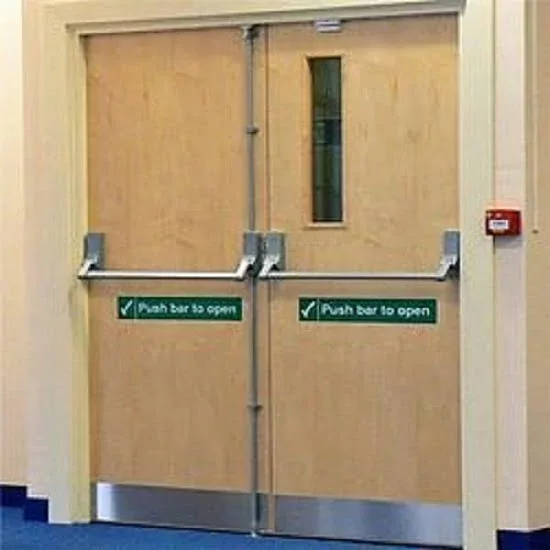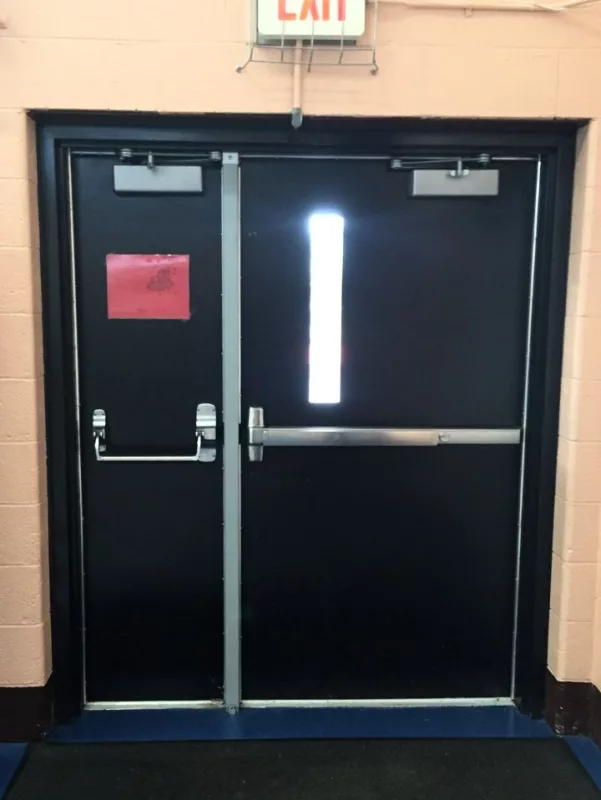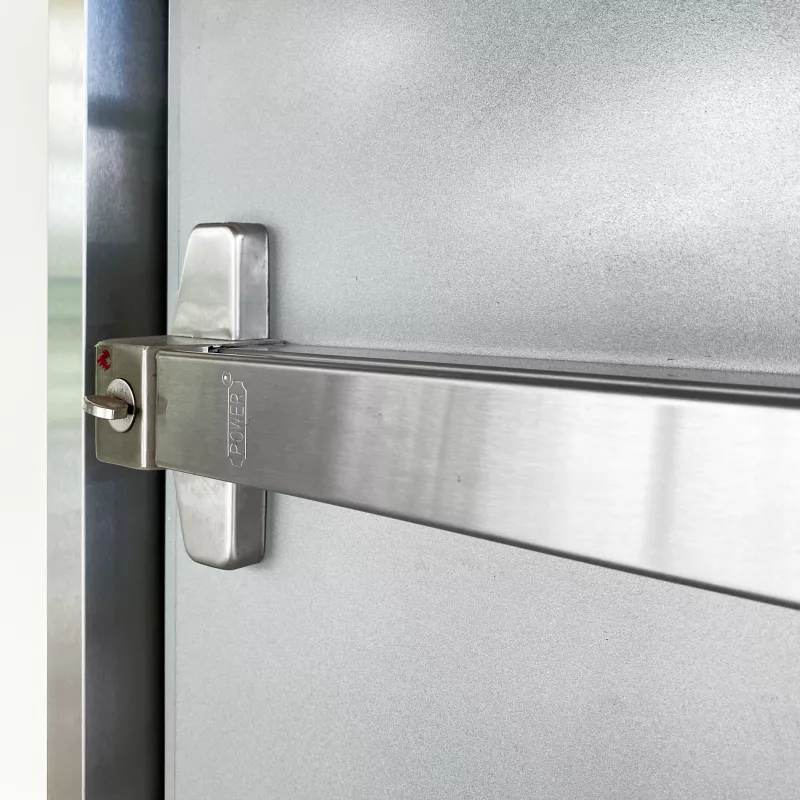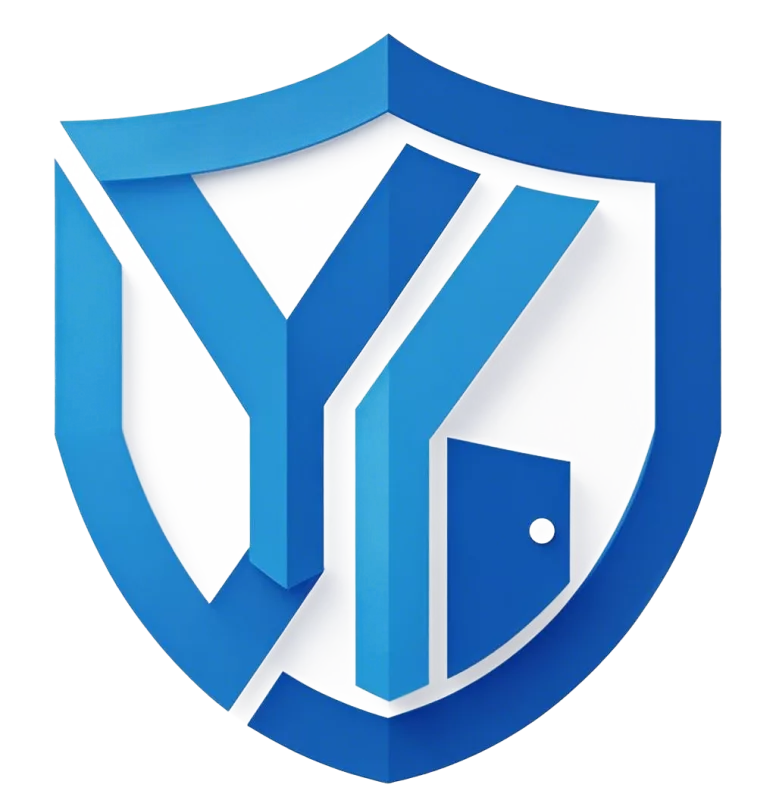Introduction: Why Choosing the Right Commercial Door Matters

At YK Commercial Door Company, we’ve always known that a door is more than just an entry point—it’s a frontline defense and a statement of our clients’ values. In safety terms, commercial doors must meet rigorous standards to safeguard occupants, whether under the stress of a fire event or the daily wear of heavy traffic. A door’s structural integrity, fire resistance, and proper sealing can be the difference between a contained incident and a catastrophic spread. That’s why we integrate fire door technology alongside our standard commercial door offerings: each product is designed to blend uncompromising protection with smooth operation and long-term durability.
Functionality is just as crucial. Doors in busy environments must operate seamlessly—opening and closing without hesitation, with hardware calibrated for the specific weight and usage frequency. We customize tracks, hinges, and closer mechanisms to fit the unique demands of every project, from a warehouse loading bay to a hospital corridor. Meanwhile, aesthetics play their own vital role. A well-designed door contributes to a welcoming entrance, reinforces brand identity, and maintains architectural harmony. Whether through powder-coated finishes, glass inserts, or crafted wood veneers, our solutions prove that safety and style can coexist without compromise.
Common Use Cases: Retail, Industrial, Hospitality, and Institutional
In retail settings—storefronts, shopping centers, even pop-up venues—doors must balance inviting transparency with security and emergency readiness. We often pair our glazed commercial doors with automatic closing systems that meet door closer fire regulations, ensuring clear sightlines for customers while maintaining swift compartmentalization if a fire occurs.
In industrial facilities—factories, distribution centers, and cold-storage sites—the demands shift toward durability and environmental control. Our heavy-gauge steel commercial door models incorporate fire rated steel door cores, high-temperature seals, and reinforced panels to withstand forklift impacts, thermal cycling, and the safety requirements laid out in modern building regulations for fire doors.
Hospitality environments—hotels, restaurants, conference centers—call for refined aesthetics without sacrificing protection. Our wooden fire resistant doors and 90 minute fire rated wood doors are crafted to match interior design schemes while delivering robust fire containment. We work closely with designers to specify finishes and glazing that satisfy both interior fire door standards and brand guidelines.
Finally, institutional settings—schools, hospitals, government buildings—require doors that support high-frequency use, stringent security protocols, and clear evacuation routes. Whether it’s a fire exit door or a decorative corridor partition, we ensure every YK door meets NFPA 80 testing cycles, carries the proper Fire Door Certificate, and aligns with ADA accessibility rules. In these contexts, reliability is non-negotiable, and our end-to-end process—from material sourcing at our China fire door factory to final installation—reflects that commitment.
2.Steel Commercial Doors: Strength, Durability, Fire Resistance

At YK Commercial Door Company, our steel commercial doors deliver unmatched resilience. These fire rated steel doors withstand impacts and corrosion while complying with stringent fire door regulations. We build each unit with high-gauge steel panels and integrate intumescent seals to meet NFPA 80 standards. Whether in manufacturing plants or retail warehouses, our steel models provide peace of mind and meet the demands of heavy use.
Aluminum Doors: Lightweight, Corrosion-Resistant, Modern Appearance
Aluminum doors from YK offer a sleek, contemporary look without sacrificing performance. Their lightweight frames simplify installation and reduce wear on hardware. While aluminum itself is non-combustible, we enhance these units with fire-rated cores and certified glazing to align with building regulations for fire doors. In coastal or humid climates, aluminum resists rust and delivers longevity.
Wooden Commercial Doors: Aesthetic Appeal, Insulation, Common Uses
For spaces that call for natural warmth, our wooden commercial doors balance beauty with safety. We craft wooden fire resistant doors and fire rated wood doors to achieve both interior fire door standards and design specifications. Each door incorporates treated timber and fire-retardant cores, earning a valid Fire Door Certificate. These doors excel in hotel foyers, office suites, and educational facilities where style and performance must align.
Glass Doors: Transparency, Design, and Limitations in Security
Glass doors create open, light-filled entrances, but they require careful engineering for safety. At YK, we use fire-rated glazing panels tested to UL 1784 airflow criteria and NFPA 252 heat-transfer limits. While standard glass doors suit lobbies and showrooms, our fire-rated versions maintain evacuation visibility while fulfilling fire exit door mandates. Security considerations, such as laminated layers and secure mullions, ensure these doors meet both aesthetic and protective goals.
Fire Rated Doors: Compliance, Protection, and Fire Door Certifications
When fire containment is paramount, our fire rated doors stand ready. We design rolling shutters, overhead assemblies, and swing doors to meet door closer fire regulations and the most recent codes. Each model carries a traceable Fire Door Certificate, outlining its fire rated interior doors rating. From 20 to 120 minutes of resistance, these doors integrate seamlessly into your safety plan.
Roll-up & Overhead Doors: For Warehouses, Loading Docks, and Storage
In high-volume loading areas, roll-up and overhead systems must combine speed with reliability. Our fire rated rolling doors feature reinforced slats and sealed guides to prevent smoke passage. We adhere to strict drop-test protocols and ensure door resets according to NFPA 80. Whether protecting a cold-storage unit or a distribution center, YK’s overhead solutions deliver both operational efficiency and passive fire protection.
Security Doors: Anti-theft, Reinforced Frames, Smart-lock Integration
Security doors guard against intrusion while serving as first responders in fire scenarios. YK’s security-grade units feature reinforced cores, biometric or RFID locks, and fire-resistant layers. These steel commercial doors meet both anti-theft requirements and building regulations fire doors, offering dual protection. Our integrated smart-lock systems also link to building management platforms, giving you real-time status and remote control.
3. Key Factors to Consider When Buying Commercial Doors
Material Selection: Environment, Climate & Function
At YK Fire Door Manufacturer, we begin each project by evaluating the environment and intended use. Choosing the right material—whether a robust China steel fire door or a refined wooden fire door—ensures compliance with local fire door regulations and optimizes performance. In humid coastal regions, corrosion-resistant aluminum or stainless steel cores prevent rust, while arid climates may favor galvanized steel for its thermal stability. For fire rated wood doors in heritage buildings, we select treated timber with fire-retardant cores, balancing interior fire door standards with authentic aesthetic. Our global teams adapt material choices to regional building codes—from the NFPA-driven markets in North America to the stringent CE directives across Europe.
Durability & Lifespan: What Impacts Service Life
We recognize that a commercial door is a long-term investment. Factors such as traffic frequency, exposure to UV, and mechanical stress influence durability. Our steel commercial doors where day-to-day abuse is common—like warehouse docks—feature reinforcements and heavy-gauge panels to resist dents and deformations. In high-cycle areas, we install industrial-grade hardware and door closer fire regulation–compliant closers tested for millions of cycles. We also account for fire protection requirements: fire rated steel doors with intumescent seals and certified fire shutter systems that maintain integrity even after years in service.
Energy Efficiency: Insulated Cores & Sealing Systems
Energy efficiency plays a growing role in door selection worldwide. At YK, we offer commercial doors with multi-layer insulation cores—mineral wool or polyurethane—that reduce thermal transfer, lowering HVAC loads in extreme climates. Fit and finish are equally important: precision-engineered gaskets and thresholds create airtight seals, preventing drafts and smoke infiltration. Our fire rated doors maintain these seals under high temperatures, ensuring both safety and energy performance align with LEED, BREEAM, or local Green Building Standards.
Security Requirements: Locks & Access Control Compatibility

Security demands vary from retail storefronts to secure labs and data centers. We integrate smart-lock technology and biometric readers into our fire exit doors and fire rated interior doors, ensuring emergency egress while preventing unauthorized entry. All hardware meets door closer fire regulations. In high-risk zones, we reinforce frames and install multi-point locking systems certified to UL and EN security ratings. Our local installation teams—experienced in markets across Asia, Europe, and the Americas—ensure hardware aligns with both security protocols and fire safety codes.
Aesthetics & Branding: The Impact on Business Image
A door is a brand statement. Whether it’s a contemporary glass entry or an ornate wooden facade, YK’s designers collaborate with clients to match color palettes, textures, and finishes. Our fire rated glass doors maintain transparency and elegance while meeting NFPA 80 and EN 1634-1 standards for fire resilience. For deluxe settings, we craft bespoke veneers and architectural details without compromising on fire certification. Through consistent global quality, we help businesses reinforce brand identity at every threshold.
4. Fire Safety and Compliance Requirements
Overview of Fire Door Regulations At YK Fire Door Manufacturer, we navigate a complex landscape of standards—UL in North America, NFPA 80 protocols for drop testing, European CE markings under EN 1634‑1, and regional ISO adaptations in Asia and the Middle East. These frameworks dictate everything from material fire resistance to automatic closing mechanisms. Our role is to harmonize these regulations into each product: whether it’s a UL fire door for U.S. projects or a CE‑certified rolling shutter for European warehouses, we ensure every assembly meets or exceeds the required tests.
Fire Rated Steel Doors vs. Wooden Fire Doors Selecting between fire rated steel doors and wooden fire doors hinges on project priorities. Steel models offer superior impact resistance, minimal maintenance, and consistent performance across temperature extremes. They are ideal for high-cycle industrial or commercial settings. By contrast, wooden fire resistant doors deliver warmth and design versatility, suiting hotels, office interiors, and historic restorations. At YK, our wooden doors integrate fire‑retardant cores and intumescent seals to achieve the same 90‑ or 120‑minute ratings as steel counterparts, without sacrificing aesthetics.
Door Closer Fire Regulations and Hardware Standards Hardware plays a critical role in fire-door integrity. NFPA 80 mandates smoke‑ and heat‑triggered closers, while UL 10C specifies positive‑pressure performance. In Europe, EN 1154 defines controlled closing force. Our engineers select and calibrate closers that satisfy these door closer fire regulations, pairing them with fire‑rated hinges, latches, and vision panels. Each component undergoes rigorous cycle testing—millions of cycles in some cases—to verify reliability.
Fire Door Certificate and Labeling Requirements Every YK fire rated door carries a unique Fire Door Certificate, documenting its fire rated interior doors rating, test lab reference, installation date, and inspection log. Labels remain firmly affixed to the door edge or frame, ensuring inspectors and Authorities Having Jurisdiction (AHJ) can quickly confirm compliance. We maintain a cloud‑based registry of certificates, simplifying audits and reissue processes for our clients.
Building Regulations Fire Doors: Local Compliance Issues Local building codes vary—some jurisdictions require annual retraining for inspectors, while others mandate quarterly visual checks. For example, California’s Title 24 includes specific provisions for smoke control under high-rise scenarios, whereas Australia’s NCC references AS 1905.1 for door construction. YK’s global footprint—with installations in over 30 markets—gives us firsthand insight into these nuances. We tailor each commercial door solution to local compliance requirements, ensuring a seamless permitting process and flawless inspections.
5.At YK Door Industry, We Understand: A Fire Door Is Only as Strong as Its Hardware
Over the years, YK Door Industry has specialized in the safety of commercial buildings, gaining deep expertise in manufacturing and delivering code-compliant fire doors. We understand that a fire door is far more than just a slab—it is a certified safety system whose performance relies heavily on reliable, precision-engineered hardware. As a professional fire door manufacturer, we not only produce door leaves but also take full responsibility for the performance of each accessory working in unison with the door system.
In this article, we highlight two critical components of any fire-rated door assembly: door closers and hinges/pivots—and how YK ensures these elements perform flawlessly when it matters most.
1. Door Closers: The Silent Guard of Fire Door Readiness
In a fire-rated door assembly, the door closer is not simply a convenience—it is a critical safety mechanism. A fire door that fails to close properly in the event of a fire loses its fire resistance rating instantly. At YK, we treat door closers as essential life safety components and enforce strict quality standards.
Precise Control Over Force and Speed
Our fire-rated door closers are calibrated for specific door weights, dimensions, and fire ratings (e.g., 60, 90, or 180-minute doors). Heavy-duty fire doors require closers with enough force to ensure secure closure even when subject to air pressure differences. Closure speed is also regulated in accordance with standards such as ANSI/BHMA A156.4, striking the balance between user comfort and emergency readiness.
Reliable Performance Under Extreme Heat
True fire door closers must function even during the intense heat of a fire. That’s why we only use models featuring heat-resistant components such as high-performance hydraulic oil and seals. These closers maintain function when temperatures spike, ensuring the door remains tightly shut, preserving the fire barrier.
Certified Compatibility with Fire Doors
All closers offered by YK have passed fire safety testing and certifications such as UL, CE, and Chinese GB standards. More importantly, these closers have been tested in combination with our fire door leaves and frames, guaranteeing the entire assembly meets its designated fire resistance rating. As a certified fire door supplier, we understand the importance of system-level compatibility and certification.
Durability for High-Traffic Environments
Our door closers are engineered for longevity, especially in commercial settings where doors are frequently opened and closed. With corrosion-resistant materials and precision manufacturing, they are built to reduce maintenance costs and minimize safety risks caused by malfunction.
2. Hinges and Pivots: The Hidden Strength Behind Every Fire Door

Often overlooked, hinges and pivots are the backbone of the fire door system, especially in high-usage environments. Their quality directly impacts not only day-to-day operation but also the door’s structural stability and fire performance. At YK, we treat them as critical safety components.
Load-Bearing Strength for Heavy Fire Doors
Many of our heavy-duty fire doors feature fire-rated glass or reinforced steel elements, making them significantly heavier than standard doors. We use ball-bearing hinges and pivot systems made from high-strength steel to carry this load. Even after thousands of cycles, these components maintain proper alignment, ensuring critical door gaps remain within fire code specifications.
Stability in High Temperatures
During a fire, metals expand and can lose their mechanical integrity. That’s why our fire-rated hinges and pivots are made from special alloys and undergo heat-treatment to ensure they retain strength even after exposure to extreme heat for up to 90 minutes or 3 hours. This protects the door from sagging or falling off—vital to maintaining fire door integrity during emergencies.
Maintaining Door Alignment and Sealing Gaps
Accurate alignment is essential for maintaining the tight gaps (≤3mm) required by fire door installation standards. A misaligned or deformed door can allow flames and smoke to escape, undermining the fire compartment. Our hinges and pivots are designed for long-term stability, resisting wear and tear that leads to gap widening or door sag.
Certified as Part of a Complete System
Just like our door closers, YK’s hinges and pivots are fire-tested and certified and are installed only after verified compatibility with our door leaves and frames. We design and supply certified fire door assemblies—where all components, including the door, frame, hardware, and seals—are tested as a system. Reliable fire door components are non-negotiable for code compliance.
6. What Drives the Price of a Commercial Door? (Material, Fire Rating, Size, Customization)
The initial cost of a commercial door assembly is influenced by several interconnected factors, where fire safety requirements often significantly elevate the baseline:
- Core Material & Construction:
- Steel Doors: Often the standard for heavy-duty fire doors due to inherent strength and durability. Costs vary based on gauge thickness (lower gauge = thicker steel = higher cost & better fire/sound performance), core type (mineral core for high fire ratings like 90-minute or 3-hour doors costs more than honeycomb), and finishes (paint vs. laminate). As a steel fire door manufacturer, we see steel as the most cost-effective for achieving high fire ratings reliably.
- Aluminum Doors: Lighter and highly corrosion-resistant, ideal for specific applications. However, achieving comparable fire resistance ratings often requires more complex internal construction (special cores, intumescent seals), potentially making them costlier than steel for equivalent fire performance. Great for non-rated or lower-rated openings where weight or corrosion is the primary concern.
- Wood & Timber Doors: Offer aesthetic appeal but for fire-rated applications, solid core construction and specialized fire-retardant treatments are mandatory, significantly increasing cost compared to non-rated wood doors. Maintenance costs can also be higher. Often chosen for specific architectural aesthetics in rated fire doors where budget allows.
- Fire Rating Level: This is arguably the single biggest driver for doors requiring certification. Achieving higher fire resistance durations (e.g., 20min, 60min, 90min, 180min fire doors) demands:
- Enhanced Materials: Thicker steel, specific mineral cores, specialized fire-resistant glazing (fire-rated vision panels), and more robust components.
- Rigorous Testing & Certification: Every fire door assembly (door leaf + frame + hardware + glazing) must undergo costly third-party testing (e.g., UL, BS, EN standards) to achieve its rating. This certification cost is embedded in the price. As a certified fire door assembly manufacturer, YK absorbs significant R&D and testing costs to ensure compliance.
- Precision Manufacturing: Tolerances for fire-rated door sets are extremely tight (e.g., consistent gaps ≤ 3mm) to prevent fire/smoke passage, requiring advanced manufacturing processes and quality control. Fire door production demands higher precision than standard doors.
- Size & Configuration: Standard sizes are naturally more economical. Oversized doors (large fire exit doors), double door pairs (fire-rated double doors), or unusual shapes require more material, specialized engineering, and often custom tooling, increasing cost. Complex configurations also impact fire door installation complexity.
- Custom Design & Finishes: Architectural specifications for unique aesthetics, custom glazing patterns (fire-rated louvers or vision lights), special finishes (powder coat colors, wood veneers on fire-rated timber doors), or integration with complex access control all add layers of cost. Custom fire door solutions require dedicated engineering resources.
2. Lifecycle Cost: The True Measure of Value (Beyond Initial Purchase)
At YK Doors, we emphasize Total Cost of Ownership (TCO). The cheapest door upfront can become the most expensive over time, especially for critical fire safety doors. Consider these long-term factors:
- Maintenance & Repair Costs:
- Durability: YK’s heavy-duty commercial doors, particularly our steel fire doors, are built to withstand high traffic and harsh environments, minimizing dents, scratches, and warping that plague lower-quality doors. Reduced repairs = lower costs.
- Hardware Compatibility & Longevity: Using high-quality, correctly specified hardware (hinges, closers, exit devices – as discussed previously) on our certified fire door assemblies drastically reduces wear and tear, preventing misalignment that compromises both function and fire integrity. Cheap hardware fails faster, requiring costly replacements and potentially voiding the fire door certification.
- Finish Durability: Our high-quality finishes (e.g., durable powder coating) resist corrosion and fading, reducing the frequency and cost of repainting compared to inferior finishes common on budget fire door products.
- Energy Efficiency Savings: While often secondary to fire safety, doors contribute to a building’s thermal envelope.
- Insulated Cores: Fire-rated doors with high-performance mineral cores also offer excellent thermal insulation, reducing HVAC loads and energy costs, especially in exterior applications. This adds tangible long-term value.
- Effective Sealing: Properly installed fire and smoke door assemblies with certified perimeter seals (intumescent and smoke seals) also prevent significant air leakage, contributing to energy savings. A poorly sealing fire door wastes energy.
- Fire Door Compliance & Liability: This is paramount and directly impacts lifecycle cost:
- Reliability in an Emergency: A YK certified fire door assembly is an investment in life safety. Failure during a fire has immeasurable human cost and exposes building owners to massive liability. The cost of non-compliance fines and lawsuits dwarfs the price of a properly specified and maintained fire protection door.
- Maintenance Requirements: Fire doors require regular inspection and maintenance by qualified personnel to remain compliant (NFPA 80, local codes). YK doors, built with quality materials and hardware, are designed for easier inspection and maintenance, reducing the labor time and cost associated with upkeep compared to less robust fire-rated door products. Reliable fire door components minimize maintenance frequency.
- Longevity & Certification Integrity: A well-built fire door maintains its structural integrity and certification validity for decades with proper care, avoiding the massive cost of premature replacement of the entire fire door system.
YK Doors: Delivering Value Through Expertise and Quality
As a dedicated fire rated door manufacturer, YK Doors doesn’t just sell doors; we provide engineered life safety solutions. We understand the intricate cost factors involved in commercial and fire rated doors. While our focus on premium materials, rigorous fire testing, and precision manufacturing means we may not always be the absolute lowest initial bid, we consistently deliver the lowest long-term cost of ownership for our clients.
We achieve this by:
Providing Certified Systems: Supplying fully tested and certified fire door assemblies (door, frame, hardware) as a cohesive unit, eliminating compatibility issues and ensuring the promised fire resistance rating is achieved.
Engineering for Durability: Minimizing maintenance and repair costs over the door’s lifespan.
Ensuring Compliance: Protecting you from liability and the high costs of non-compliant fire door installations.
Optimizing Performance: Integrating energy efficiency and long-term reliability into our fire door designs.

Pingback: The Definitive Commercial Door Procurement Guide - YK | Fire Doors | Fire Windows | Fire Shutters
Pingback: Fire Door Standards Comprehensive Guide